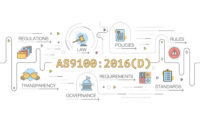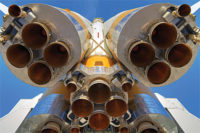In the beginning
The first international quality system standard for the aerospace industry, AS9100, was published in November 1999 by the Society of Automotive Engineers (SAE). The International Organization for Standardization (ISO) Aerospace Technical Committee 20, in conjunction with the American Aerospace Quality Group (AAQG) in the United States and the European Association of Aerospace Industries (AECMA) in Europe and other countries including China, Japan, Mexico and Brazil, developed the quality system standard for use by aerospace companies. It was the first single standard available for use across the global aerospace community and supplemented ISO 9000 requirements with those necessary to address civil and military aviation, and aerospace needs.
In North America, AS9100 replaces AS9000 as the registration standard for suppliers to the aerospace industry. AS9000 was based on input by a number of large aerospace prime contractors, including GE Aircraft Engines, Lockheed Martin and Northrop Grumman.
Also known as...
The International Aerospace Quality Group (IAQG) supported development of the global standard. AS9100 was released in the United States, Europe and Japan as AS9100, PrEN 9100, and the Society of Japanese Aerospace Companies (SJAC) 9100 respectively.
The standard quickly found acceptance at major aerospace manufacturers including The Boeing Co., General Electric Aircraft Engines and Rolls-Royce Corp., which immediately began specifying compliance with AS9100 as a vendor qualification requirement.
The IAQG: who are they?
The IAQG, the organization that wrote the standard, is sponsored by three organizations:
- The European Association of Aerospace Industries
- The Society of Automotive Engineers
- The Society of Japanese Aerospace Companies.
The IAQG sets the policy, purpose and objectives of the organization and drives initiatives to meet the goals and objectives of the organization. IAQG's General Assembly is a communication forum for the aerospace community worldwide, and all members are encouraged to provide input.
IAQG's goal is to establish and maintain dynamic cooperation on international aerospace quality standards and to make a significant improvement in quality and reduction in cost throughout the value stream. The IAQG focuses on the continuous improvement of the processes within the supply chain to deliver consistently high-quality products.
Members are selected by the organizations and represent the largest aerospace companies in the world. All prime aerospace industry companies are eligible to be members of the IAQG General Assembly.
Why the new standard?
The IAQG agreed in March 2000 to align the requirements of ISO 9100, AS9100, PrEN 9100 and SJAC 9100 with the requirements ISO 9001: 2000. The IAQG has established an international team to align the specific industry requirements contained within 9100 to the revised content and format of ISO 9001: 2000 version. The existing version of ISO 9100 and AS9100 will remain available for use until November 2003, allowing users time to transition to the new version under development.
The revision to the basic quality system AS/EN/JIS Q 9100: 2001 standard for the aerospace industry became available from the SAE in June 2001. SAE officials are expected to allow their counterparts in Europe and Asia to accept the revisions. It will co-exist with AS/EN9100: 1999 and will accomplish the alignment with ISO 9001: 2000.
AS9100 was developed from the framework of ISO 9001 and the existing North American and European aerospace standards AS9000 and EN9000-1, and expands their requirements to provide a standard that meets the needs of aerospace manufacturers worldwide. These expanded requirements include configuration management, reliability, maintainability, safety and special processes. AS9100, like its predecessor, AS9000, seeks to ensure customer satisfaction by having aerospace industry manufacturers produce world-class quality products at the lowest possible cost. AS9100 standardizes, to the maximum extent possible, the quality system requirements of the aerospace industry. Standardization of these requirements should result in cost savings to both vendor and contractor through the elimination or reduction of unique requirements developed for each different customer.
The revised AS9100 is identical in clause structure with ISO 9001: 2000. All the expectations were merely taken out of the old AS9100 editions and placed into the new standard. Although no new requirements were added, the revised document does reinstate certain language on inspection and test that was dropped from ISO 9001: 1994.
However, suppliers that have already implemented AS 9000 and have mature quality systems, may find that only relatively minor changes to their systems are necessary to meet the new requirements. In addition to the requirements listed in ISO 9001: 1994, AS9100 also includes aerospace sector-specific requirements considered necessary to ensure the safety, reliability and quality of aerospace products. These include requirements in the areas of:
- Configuration management
- Reliability, maintainability and safety
- Design phase, design verification, validation and testing processes
- Approval and review of subcontractor performance
- Verification of purchased product
- Product identification throughout the product's life cycle
- Product documentation
- Control of production process changes
- Control of production equipment, tools and numerical control machine programs
- Control of work performed outside the supplier's facilities
- Special processes
- Inspection and testing procedures
- Methods, resources and recording
- Corrective action
- Expansion of the internal audit requirements in ISO 9001
- First article inspection
- Servicing, including collecting and analyzing data, delivery, investigation and reporting; control of technical documentation
- Review of disposition of nonconforming product.
The quality system requirements specified in the international standard were intended to be complementary to contractual requirements, applicable law and regulatory requirements. Un-like standards in other areas, AS9100 recognized the role of various gov-ernment and industrial regulatory authorities in the establishment of quality system requirements for aerospace manufacturers.
Backed by the FAA
The new specification also responded to concerns raised by the Federal Aviation Administration (FAA) to place far greater emphasis on supplier con-trol. During a recent meeting of the IAQG, the FAA Production and Air-worthiness Certification Division (AIR-200) made a proposal to issue a letter recognizing SAE AS9100 as a quality management system standard for aviation related industries. AIR-200 performed extensive comparative reviews and found AS9100 to be a comprehensive quality standard containing the basic quality control elements required by the current Code of Federal Regulations. In addition, if effectively employed, the quality control system should also meet the FAA's exceptions for a manufacturing quality control system.
AS9100 and Boeing
Boeing, the world's largest aerospace manufacturer, expects about 3,000 of its suppliers to comply with AS9100 during the next two years. Boeing is expected to make a formal announcement to suppliers on the details of its expectations. Boeing is sensitive to the issue of change and is offering latitude as suppliers attempt to adjust to the differences between versions of ISO 9001 and AS9100. Boeing has asked its supplier base to transition from legacy quality systems such as D1-9000, MIL-Q-9858A, MIL-1-45298 and others, to the Boeing Quality Management System. Boeing is also walking the walk; its aircraft and missiles group and many other facilities are registered or currently in process. However, this demand on the supplier base to adopt AS9100 is taking place across the board in the aerospace industry, not just at Boeing.
The American Aerospace Quality Group (AAQG) and the Registrar Accreditation Board (RAB) have developed a sanctioned process for use of third-party registrars in connection with AS9100. RAB is reviewing registrars and collecting information the aerospace industry needs to ensure that registrars are competent in the application of the standard in the industry. Auditors also must be specifically approved to the standard. The AAQG registrar management committee reviews the data RAB collects and then determines that a registrar or auditor is competent in the AS9100 world.
What's required
The requirements for registration of an aerospace manufacturer's quality management system to AS9100 are contained in "SAE AIR 5359, Requirements for Registration of Quality Systems to AS9000 or AS9100," developed by the AAQG. These requirements are to be applied by the American National Standards Institute Registrar Accreditation Board or by other registrar accreditation bodies. Requirements include:
- Assignment and quality classifications of auditors and auditor team
- Auditors must have aerospace experience in four of the last 10 years
- Auditor team must have one experienced aerospace auditor
- Registrar must be approved by AAQG
- AAQG reserves the right to view and review the registrar audits
- The audit must include the use of AS9100 check list.
Registrars must meet the criteria listed in this document. Aerospace companies should check with their customers regarding the use of AS9100 and any requirements for registration.

